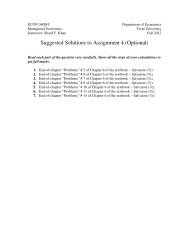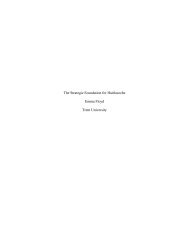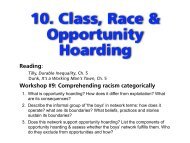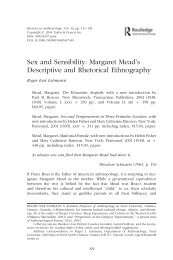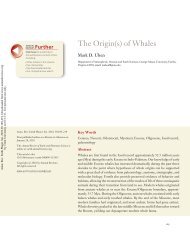REO FORTUNE'S PSYCHOLOGICAL THEORY OF CULTURAL ...
REO FORTUNE'S PSYCHOLOGICAL THEORY OF CULTURAL ...
REO FORTUNE'S PSYCHOLOGICAL THEORY OF CULTURAL ...
Create successful ePaper yourself
Turn your PDF publications into a flip-book with our unique Google optimized e-Paper software.
278 Pacifi c Studies, Vol. 32, Nos. 2/3—June/Sept. 2009<br />
The units of waking cognition are “sentiments.” Fortune (1927, 88)<br />
defined a sentiment as “an organized system of emotional tendencies<br />
grouped about an object and the idea of an object.” The units of dreaming<br />
cognition, by contrast, are “constellations.” A “constellation is a collection<br />
of ideas perceived in hallucinatory fashion as objects, disrupted from the<br />
sentiments of which they form the core, and regrouped about an emotional<br />
tendency which their respective sentiments have in common” (1927: 88–89,<br />
italics in original). Fortune implied that constellations, which are unconscious<br />
in waking life, often contradict sentiments, are more resilient than<br />
sentiments, and preserve ideas that have been rejected or repressed.<br />
For Fortune, constellations associate representations in “unconscious<br />
thought” (unavailable in waking life but accessed in dreaming) through<br />
“association by common feeling tone.” Common affect is the primary means<br />
by which the mind in sleep connects representations to form constellations.<br />
When conscious ideology begins to invade the dream as one approaches<br />
waking, affective constellations are replaced with “surrogate constellations”:<br />
The surrogate constellation is formed by two ideas, perceived in<br />
hallucinatory fashion as objects, disrupted from the sentiments of<br />
which they form the core, and regrouped about an emotional<br />
tendency which their respective sentiments have in common, but<br />
which is more strongly repressed in one sentiment than in the<br />
other. (Fortune 1927, 89, italics in original)<br />
Surrogate constellations connect representations through “verbal similarity”<br />
(puns), and “simulacral association” (assigning attributes of one event to<br />
another) (Fortune 1927: 101–4). Thus, Fortune concerned himself with<br />
both pure dream cognition, characterized by affective association, and<br />
mixed dreaming/waking cognition, characterized by simulacral association.<br />
Because of their distinctive modes of connecting ideas and feelings, they<br />
allow the expression of attitudes repressed by the conscious mind as it<br />
confronts physical reality and its sociocultural and logical constraints.<br />
Fortune’s book concludes with the suggestion that dreaming evolved to<br />
balance individual and social needs:<br />
The organization of emotions around an object is the normal mode<br />
of working of the waking mind. The organization of objects about<br />
an emotion, on the other hand, is a normal mode of working of<br />
the dreaming mind. (Fortune 1927, 88)<br />
These two modes evolved “to keep incompatible suggestion separated”<br />
(Fortune 1927, 88). By this Fortune meant preventing conflicts between<br />
pacs-32-02-06.indd 278 9/7/2009 2:32:33 PM



